Physical Address
304 North Cardinal St.
Dorchester Center, MA 02124
Von Willebrand factor (VWF) is an adhesive multimeric plasma glycoprotein (GP) that mediates platelet adhesion to injured subendothelium via GPIbα, and binds and stabilizes factor VIII (FVIII) in the circulation, protecting it from proteolytic degradation. This important multifunctional protein was named after the Finnish physician Dr. Erik von Willebrand, who first described von Willebrand disease (VWD) in 1926. In the original publication, he described a severe mucocutaneous bleeding problem in a family living on the Åland archipelago in the Baltic Sea. The index case, a young woman named Hjördis, bled to death during her fourth menstrual period at the age of 13. Dr. von Willebrand referred to the condition as pseudohemophilia , but noted that in contrast to hemophilia, this condition affected both genders, with females typically being more severely affected.
In the mid-1950s, it was recognized that VWD was usually accompanied by a reduced level of FVIII activity, and that the bleeding phenotype could be corrected by the infusion of normal plasma. In the early 1970s, the critical immunologic distinction between FVIII and VWF was made, and since that time significant progress has been made in our understanding of the molecular pathophysiology of this disorder. Cloning and characterization of the VWF gene in the 1980s has facilitated further investigation into the function of VWF and the genetic basis of VWD.
VWF is a multifunctional adhesive protein that plays an important role in both primary hemostasis and blood coagulation. In primary hemostasis, VWF initiates platelet adhesion at the site of endothelial injury, whereas in coagulation, VWF stabilizes FVIII in the circulation ( Fig. 133.1 ).
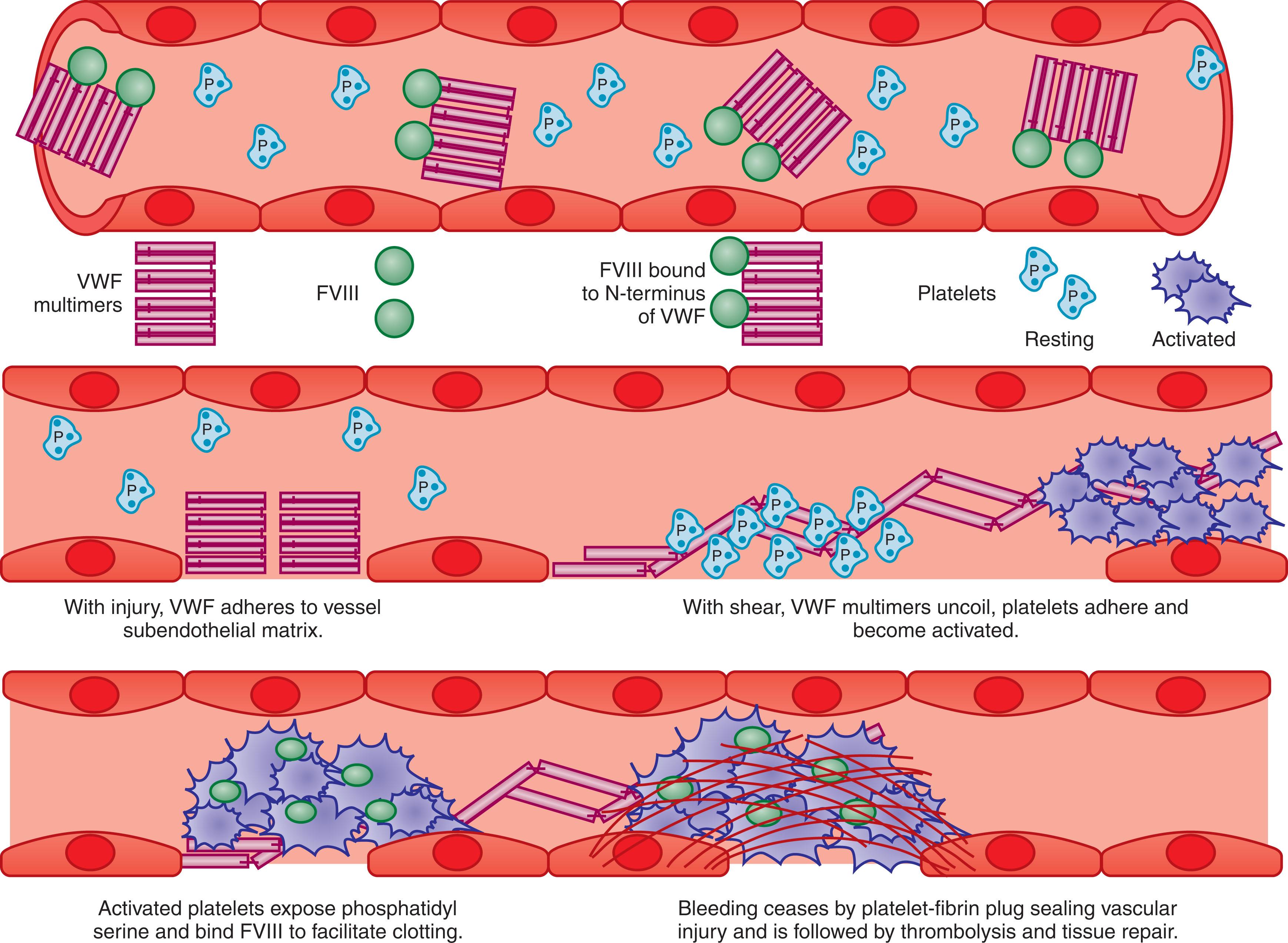
At the site of endothelial injury, VWF adheres to exposed collagen. The hemostatically important forms of collagen include types I, III, and VI, but VWF preferentially binds to type III collagen. The interactions of VWF with collagen are predominately mediated by the VWF A3 domain ( Fig. 133.2 ). Once immobilized, VWF is subjected to the high shear rates of the arterial circulation and undergoes a conformational change that exposes the platelet GPIbα binding site within the VWF A1 domain. High affinity, rapid, and reversible interaction between VWF and GPIbα tethers platelets to the endothelium, where they roll until they are immobilized and activated by direct platelet-collagen binding, which is mediated by two collagen receptors on platelets, GPVI and the integrin α2β1 (or GPIa/IIa). The Arg-Gly-Asp (RGD) sequence within the VWF C1 domain also contributes to platelet adhesion by interacting with GPIIb-IIIa of activated platelets.
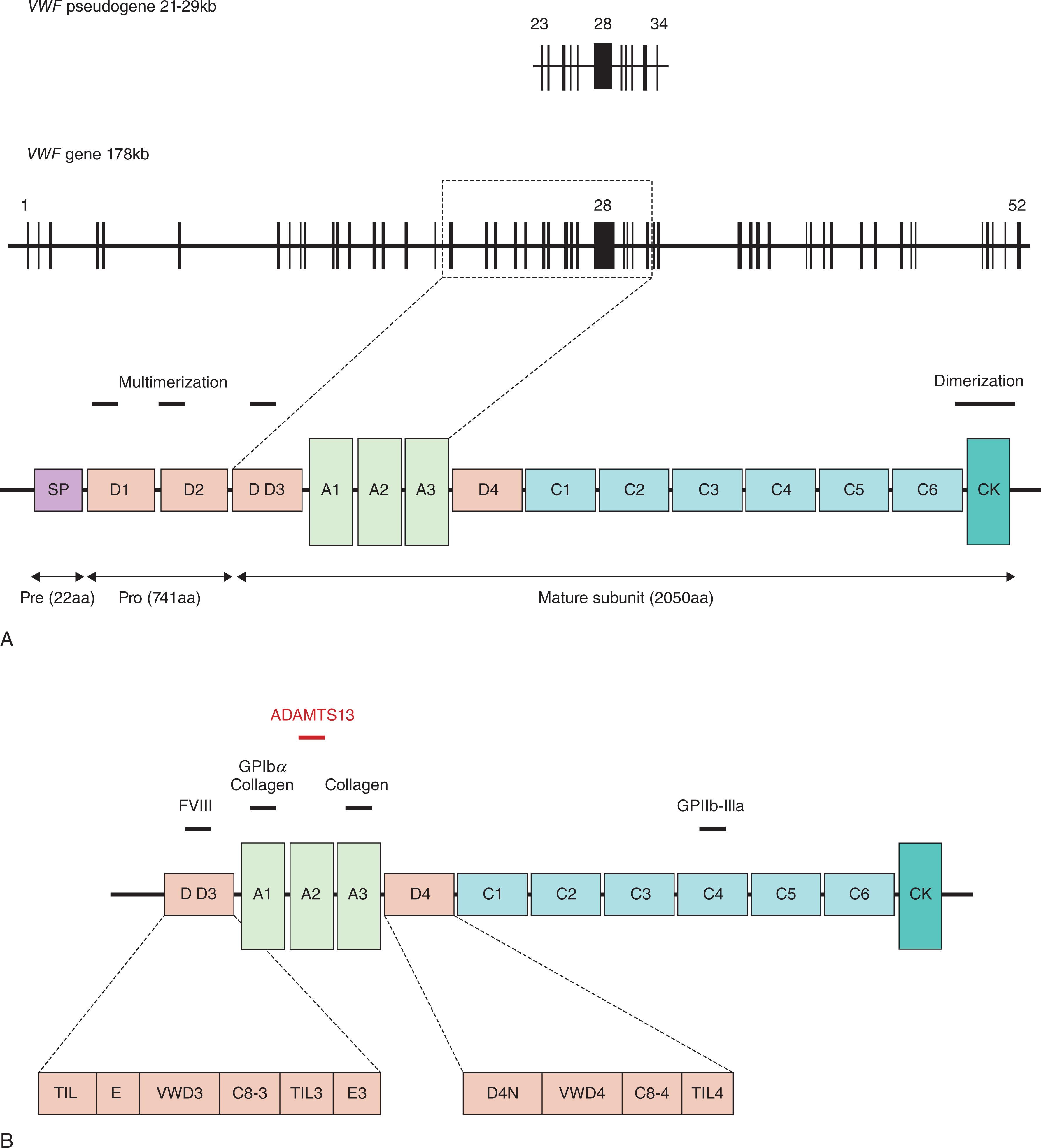
VWF binds FVIII through the VWF D′D3 domains and protects it from proteolytic degradation, thereby prolonging its half-life. In the absence of VWF, FVIII has a half-life of approximately two hours in contrast to a half-life of 12 to 20 hours when bound to VWF.
The normal level for VWF is highly variable and ranges from 50 to 200 IU/dL. Factors that contribute to the variable VWF levels include ABO genotype (see section on ABO blood groups later), Secretor genotype, race, and age. Plasma VWF concentrations have been reported to be approximately 20% higher in subjects homozygous for the Secretor (Se) allele as compared with those who are heterozygous. VWF levels in African Americans are 15% higher than in those of European descent. Increased age has also been associated with higher VWF levels, with studies suggesting that the levels may increase by 3.5 IU/dL per decade.
Within individuals, VWF levels often vary over time as a result of β-adrenergic stimuli, drugs, or more sustained physiologic factors, such as pregnancy, hypothyroidism, chronic illness, or long-term use of certain medications. The vasopressin analogue, 1-deamino-(8- d -arginine)-vasopressin (DDAVP, desmopressin) transiently and reliably increases VWF and FVIII levels—a fact that, in addition to an acceptable side effect profile, has led to the use of DDAVP as a first-line treatment in certain types of VWD and mild hemophilia A. Several physiologic stressors involving β-adrenergic stimulation, such as exercise, surgery, and psychological distress, can produce an acute increase in VWF levels. VWF levels remain elevated for up to 6 days after surgery, suggesting that after the acute secretory response, there is upregulation of VWF production. A sustained elevation of VWF levels can occur with chronic diseases, such as hyperthyroidism, renal failure, diabetes, liver disease, atherosclerosis, chronic inflammatory states, and cancer. Conversely, acquired VWD, characterized by qualitative or quantitative VWF defects, can occur with certain medications, such as valproic acid, and with some chronic medical conditions (see section later on acquired VWD).
VWF levels are increased by estrogen. In premenopausal women, VWF levels vary in a cyclical fashion, with the lowest levels occurring in the early follicular phase of the menstrual cycle (days 1 to 7), and peak values occurring during the luteal phase. Oral contraceptives increase VWF levels and dampen the cyclical variation. This dose-dependent effect is mediated by the estrogen component and is evident with ethynylestradiol doses of 0.5 μg or higher. Lower estrogen doses have little or no effect on VWF levels. VWF levels increase in pregnancy starting in the second trimester and achieve levels threefold higher than baseline values by the end of the third trimester. VWF levels return to baseline 1 to 3 weeks after delivery.
Located on the short arm of chromosome 12 at p13.3, the VWF gene spans 178 kb and is composed of 52 exons that range in size from 1.3 kb (exon 28) to 40 bp (exon 50) (see Fig. 133.2A ). There is a partial, unprocessed pseudogene, VWFP , located on the long arm of chromosome 22 at q 11.2, measuring 21 to 29 kb, which duplicates the VWF gene sequence for exons 23 to 34 with 97% sequence homology. Gene conversion events involving the pseudogene contribute to the variant spectrum of VWD. The VWF gene is highly polymorphic. Analysis of the 1000 Genomes database has revealed more than 2700 single nucleotide variants (SNVs) in the normal population alone. These variants are found throughout the coding sequence as well as in intronic regions, and appear to occur at a rate of ~2.5 variants per individual. The majority of these are rare variants, the pathological significance of which remain unclear, but a significant portion are associated with non-synonymous coding sequence changes, splice site changes or insertion/deletions. An International Society on Thrombosis and Haemostasis Scientific and Standardization Committee (ISTH-SSC) database of both benign and pathogenic variants is maintained by the European Association for Haemophilia and Allied Disorders ( https://dbs.eahad.org/upcoming-vwf-db/ ). The high degree of polymorphism, the large size, and the presence of the pseudogene render full VWF gene sequencing and data interpretation challenging.
VWF expression is tightly restricted to endothelial cells and megakaryocytes. Cell-specific transcriptional regulation is complex and poorly understood. A 734-base pair region, spanning approximately 500 bases of the 5′-flanking region and 247 bases of the first exon, functions as a promoter and includes a minimal core promoter, as well as negative and positive regulatory regions. The positive regulatory region confers cell-specificity by relieving inhibition in specific cells, thereby allowing transcription of the VWF gene.
Encoded VWF messenger ribonucleic acid is 8.8 kb in length and the translated pre-pro-VWF molecule contains 2813 amino acids (AA), comprising a 22 AA signal peptide, a 741 AA propeptide, and a 2050 AA mature subunit that possesses all the adhesive sites required for hemostatic activity. The AA sequence is cysteine rich, with cysteine residues constituting 8.3% of the total amino acid content. Cysteine residues are mainly found clustered in the N- and C-termini where they are involved in extensive intra- and inter-molecular disulfide bonding. Cysteines are least abundant in the VWF A domains, which contain just six cysteine residues. Both the A1 and A3 domains take on the form of disulfide-bonded loops, while the A2 domain possesses a rare vicinal disulfide that contributes to domain stability.
The VWF AA sequence exhibits considerable internal homology and comprises a series of repeated domains (A, C, and D), which make up approximately 90% of the precursor. These repeated domain structures are highly homologous to domain structures found in many unrelated proteins. For example, the VWF A domain is the prototype for a protein superfamily and appears in up to 22 human proteins, such as leukocyte adhesion receptors, collagen receptors, and cartilage matrix protein. Likewise, homologues of the VWF C, D, and cysteine knot (CK) domains exist throughout the genome and are found in proteins with various functions. This suggests that the VWF gene is the product of a complex series of partial gene duplications.
Based on the homologous internal repeat structure, the domain composition of VWF is given as NH2-SP-D1-D2-D’-D3-A1-A2-A3-D4-C1-C2-C3-C4-C5-C6-CK-COOH. The D domains are further divided into VWD, C8, TIL, and E subdomains. D’ is a truncated assembly containing only the TIL and E subdomains. The D1, D2, and D3 assemblies comprise VWD, C8, TIL, and E subdomains, while the D4 assembly lacks the E subdomain, but carries a unique subdomain structure designated D4N (see Fig. 133.2B ).
The functional significance of many of the individual VWF domain structures has been established. The signal peptide (S) targets pre-pro-VWF to the endoplasmic reticulum (ER), where it is promptly cleaved. The CK domains of adjacent VWF monomers form disulfide bonds, resulting in tail-to-tail dimers that initiate the multimerization process. The VWF propeptide (D1D2) plays a critical role in VWF multimer assembly by promoting the formation of head-to-head oligomers via intermolecular disulfide bonding between D3 domains of adjacent VWF dimers.
Several functional sites that are critical for the regulation of hemostatic activity have also been identified. The D′D3 assembly constitutes the FVIII interactive region of VWF, with the bipartite FVIII binding site encompassing the noncontiguous TIL′ and C8-3 subdomains. The hemostatically active A domains comprise several key binding and regulatory sites. Binding sites for platelet GPIbα, heparin, and collagens I, III, and VI have been localized to the A1 domain, though the major collagen III binding site localizes to the A3 domain. The A2 domain contains the cryptic cleavage site for the regulatory protease ADAMTS13 (a disintegrin and metalloproteinase with a thrombospondin type 1 motif, member 13), with the scissile bond located between Tyr1605-Met1606. The platelet GPIIb/IIIa binding site is found within the RGD motif of the C4 domain.
VWF is exclusively synthesized in endothelial cells and megakaryocytes and undergoes a complex series of co- and post-translational modifications, including dimerization, glycosylation, sulfation, and ultimately, multimerization. The fully processed protein is then either released into the circulation or is stored in specialized organelles: the Weibel-Palade bodies (WPBs) of endothelial cells or the α-granules of platelets.
Dimerization of pro-VWF monomers occurs in the ER through the formation of disulfide bonds between CK domain monomers in a tail-to-tail fashion. The location of these intersubunit disulfide bonds has been localized to a subset of cysteine residues (Cys2771, Cys2773, and/or Cys2811). In addition, the signal peptide is cleaved and most of the intrachain disulfide bonds are formed in the ER. Only pro-VWF dimers are then transported to the Golgi apparatus. Exiting the ER appears to be the rate-limiting step in VWF biosynthesis.
In the Golgi, pro-VWF dimers make up the basic building blocks for further multimerization. Here, the propeptide (D1D2) is cleaved by a propeptide processing protease, likely furin, between AA 763 to 764. The propeptide continues to be essential for VWF multimerization because under acidic conditions, it serves as an endogenous chaperone that promotes additional disulfide bond formation between D3 domains of adjacent dimers in a head-to-head orientation. The inter-subunit disulfide bonds are likely mediated by the alignment of the cysteine pairs Cys1099 and Cys1142. The VWF subunit is approximately 250 kDa, whereas resulting disulfide-linked multimers can be more than 20,000 kDa.
The mature VWF subunit is heavily glycosylated with the carbohydrate component making up approximately 20% of the monomeric mass. VWF expresses both N- and O-linked glycan structures which are important regulators of its functional activity, modifying its plasma half-life as well as its susceptibility to regulatory proteolysis by ADAMTS13. In the ER, N-linked glycosylation begins as a co-translational event and 13 N-linked high-mannose-containing oligosaccharide chains are added to each VWF subunit. In addition, the propeptide has four potential N-glycosylation sites. The mannose-rich core is remodeled by a series of glycosyltransferases and glycosidases as the protein transits the ER, facilitating interaction with resident ER chaperones that direct protein folding and subsequent dimerization. Dimerization is absolutely dependent on the addition of N-linked glycans.
Post-translational modification occurs in the Golgi with the addition of 10 O-linked oligosaccharides to the pro-VWF dimer. O-linked glycans are assembled via sequential addition of monosaccharide units rather than by transfer of a preassembled core. N-linked glycans undergo further processing to produce complex-type carbohydrate structures and sulfation of specific N-linked glycans (Asn1147 and Asn1231) occurs in the trans-Golgi network. Finally, both the N- and O-linked glycan structures are modified with capping terminal sialic acid moieties and unusually, approximately 13% of the N-linked and 1% of the O-linked glycans are modified to express ABO(H) antigenic determinants. Overall, the VWF glycome represents an extremely heterogeneous population of sugars. To date, over 300 distinct VWF N-linked glycan structures alone have been described.
Interestingly, platelet-VWF exists as a natural glycoform and has distinct functional characteristics. Terminal sialic expression on the N-linked glycans of platelet-VWF is reduced twofold and although H-antigen expression is comparable to that of its plasma-derived counterpart, further modification of the H antigen to produce group A or B determinants does not occur. As a direct consequence of its differential glycosylation, platelet-VWF is significantly more resistant to ADAMTS13-mediated proteolysis than plasma-derived VWF.
The majority of the VWF in endothelial cells consists of low-molecular-weight (LMW) multimers that are constitutively secreted. The more biologically active high-molecular-weight (HMW) VWF multimers are preferentially targeted for storage in endothelium-specific cytoplasmic granules, the WPBs. The biogenesis of WPBs is driven by VWF itself. In addition to VWF and the VWF propeptide (VWFpp), numerous other proteins that are essential to hemostasis and inflammation, and to modulation of vascular tone and angiogenesis, are stored in WPBs including P-selectin, CD63, interleukin-8 (IL-8), tissue plasminogen activator, and angiopoietin-2 (Ang-2). WPBs have a characteristic cigar-like shape, measuring 0.2 μm in width and 5 μm in length ( Fig. 133.3 ), and are composed of tightly packed tubules, measuring 150 to 200 Å in cross-section. Platelet VWF is stored within similar tubules that are found in the periphery of α-granules, and constitutes approximately 15% to 20% of total circulating VWF. Tubular packing condenses the length of VWF multimers by 50-fold and is dependent on the acidic pH within the trans-Golgi, as well as the propeptide (D1D2) and the NH 2 -terminal region (D′D3A1). Large VWF multimers, which can be up to 100 μm in length, are reversibly packaged into coils. Upon WPB exocytosis, the filamentous strings of VWF are secreted into the circulation, where they rapidly unfurl and are capable of binding to platelets. If the tubular structure is perturbed, WPBs release short, tangled VWF that does not support platelet binding to the endothelium.
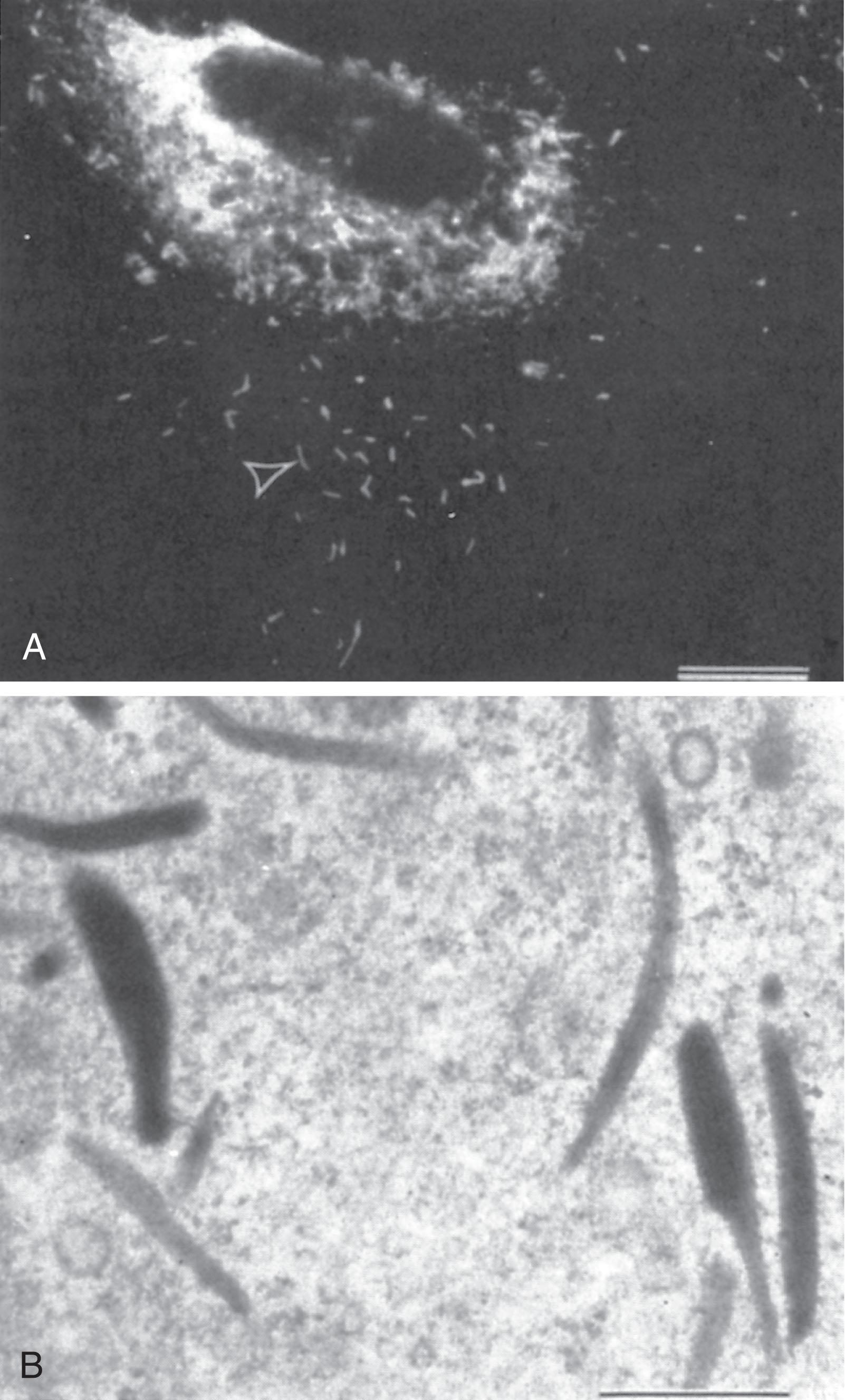
VWF is secreted via three pathways—constitutive, basal, and regulated release. Regulated VWF release is via an acute pathway that is triggered by agonist-mediated activation of the endothelium. Basal secretion from WPBs occurs continuously and is likely in response to background levels of agonists and, possibly, also due to mechanical stimulation from the circulating blood. The continuous basal release of VWF is likely to be the source of circulating plasma VWF, whereas the acute regulated release of VWF provides a localised dose of ultra-large VWF (UL-VWF) to initiate primary hemostasis at times of injury.
A variety of agonists can induce the secretion of VWF from endothelial cells. These agonists include histamine, thrombin, fibrin, the terminal complement proteins C5b-9, and β-adrenergic agonists. These agonists work via two main pathways to raise the intracellular levels of either (1) Ca 2+ or (2) cyclic adenosine monophosphate (cAMP). Upon endothelial stimulation, WPBs release their contents through one of three modes of exocytosis, depending on the type and amount of protein that is required. VWF is released via full fusion of WPB with the plasma membrane. The freshly secreted unusually large, or UL-VWF, multimers are highly active and can spontaneously bind platelets. Some of the released protein remains associated with the endothelial membrane and some self-associates.
ADAMTS13 is a constitutively active plasma protease that cleaves circulating VWF between Tyr1605-Met1606 in the A2 domain. Its main target is the UL-VWF multimers, which spontaneously bind platelet GPIbα. ADAMTS13 cleaves UL-VWF multimers when there is sufficient shear-stress to unfold the A2 domain to expose the cryptic cleavage site. UL-VWF multimers that appear in plasma after WPB secretion are cleaved within 2 hours by ADAMTS13 to form LMW, or less hemostatically active multimers. ADAMTS13-mediated proteolysis of VWF is responsible for the characteristic “triplet” pattern of the satellite bands that flank each main multimer band on multimer analysis gels ( Fig. 133.4 ).
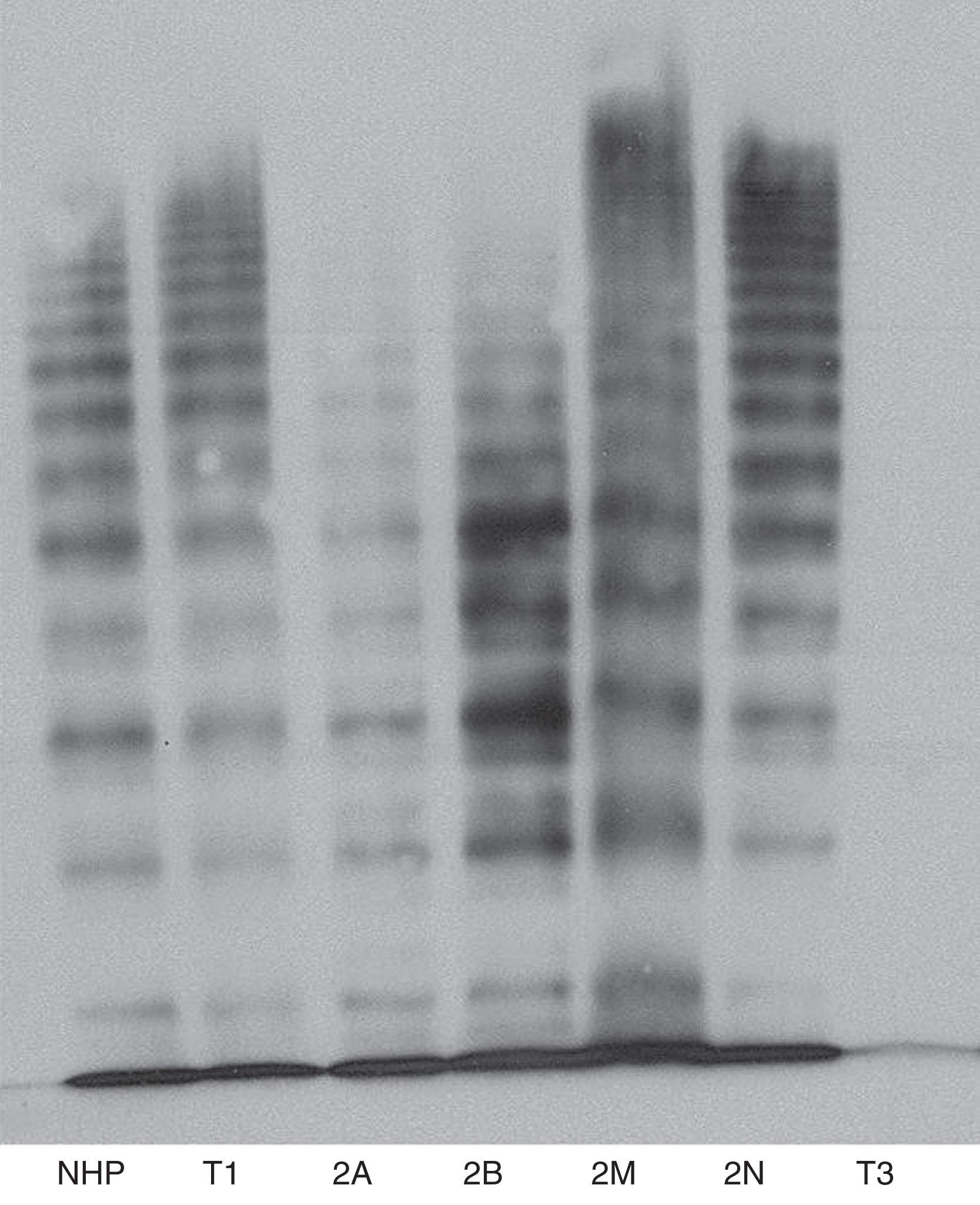
Susceptibility to ADAMTS13 proteolysis is influenced by glycosylation and specific VWF sequence variants. De-glycosylated plasma-derived VWF is proteolyzed more rapidly than fully glycosylated VWF, and blood group O VWF is cleaved more rapidly than non-O VWF in the order O ≥ B ≥ A ≥ AB. Moreover, Bombay-VWF is proteolyzed even more rapidly than group O VWF. In addition, although terminal α2–6 linked sialic acid expression protects VWF from spurious proteolysis by plasma cysteine and serine proteases, it specifically targets VWF for proteolysis by ADAMTS13. Single-nucleotide variants, such as the c.4751 A > G variant giving rise to p.Tyr1584Cys in the VWF A2 domain, have also been shown to affect the susceptibility of VWF to proteolysis.
Alterations in the balance between ADAMTS13 activity and VWF proteolysis can lead to several disease states. Congenital or acquired deficiency of ADAMTS13 can result in thrombotic thrombocytopenic purpura (see Chapter 132 ). Conversely, enhanced proteolysis can give rise to a bleeding phenotype. For example, in a subtype of type 2 A VWD, variant VWF exhibits enhanced susceptibility to ADAMTS13 cleavage which results in loss of large VWF multimers.
VWF clearance is a complex multifactorial process that involves numerous endocytic receptors expressed on a variety of cell-types. Hepatic and splenic macrophages, as well as sinusoidal endothelial cells, represent the cell types thought to contribute most significantly to VWF clearance, though hepatocytes also have an established role. Following the identification of the asialoglycoprotein receptor (ASGPR) as the first receptor capable of mediating VWF removal from the plasma, several additional VWF clearance receptors were described. Macrophage receptors LRP1, SR-AI, MGL, and endothelial receptors CLEC4M, stabilin-2 and SCARA5 have all been shown to bind and endocytose VWF. Although the exact molecular mechanisms underlying each of these VWF clearance pathways have not been fully elucidated, it is clear that both glycosylation and VWF sequence variation modulate VWF uptake. Blood group O individuals (see the following section on ABO Blood Groups) exhibit increased VWF clearance compared to non-O blood types displaying shorter VWF survival following DDAVP administration. Additionally, a growing number of missense sequence variants have been associated with accelerated VWF clearance. To date >30 variants have been described. Most of these cluster around the VWF D3 and A1 domains, but variants have been described throughout the entirety of the coding sequence. Accelerated clearance has been associated with type 1, type 2 A, and type 2B phenotypes.
The VWFpp is co-secreted with mature VWF in a 1:1 stoichiometric ratio. After secretion, the VWFpp dissociates from VWF and circulates with a half-life of 2 to 3 hours. In contrast, VWF circulates with a half-life of approximately 12 to 20 hours. These discordant clearance rates mean that the ratio between VWFpp and VWF can be used as a surrogate marker for altered VWF clearance. A ratio >2.2 is considered indicative of accelerated or pathological VWF clearance.
ABO blood groups differ only with respect to a single terminal sugar residue. Despite this relatively minor modification to the glycan chain, ABO blood group expression has a significant quantitative effect on plasma VWF levels. Blood group O individuals have plasma VWF levels that are on average 25% lower than those with non-O blood types: the mean VWF level in blood group O subjects is 74.8 IU/dL as compared to 105.9 IU/dL, 116.9 IU/dL, and 123.3 IU/dL in blood group A, B, and AB subjects, respectively. Plasma VWF levels are further reduced in individuals with the rare Bombay phenotype. An accumulating body of evidence suggests that differential VWF clearance is responsible for this quantitative effect, though the receptor responsible for mediating this phenomenon has not been identified. Blood group O individuals have a significantly shorter VWF half-life following DDAVP infusion compared to non-O individuals (Group O vs non-O: 10.0 vs 25.5 hours respectively). In addition, group O individuals also have significantly elevated VWFpp/VWF:Ag, indicating an increased rate of VWF clearance. Clinically, the ABO-related variance in VWF levels is relevant; patients with blood group O are significantly overrepresented in “low VWF” or type 1 VWD populations. However, in laboratory practice, blood group stratified VWF reference ranges are not employed.
The role of VWF in the regulation of vascular endothelial growth factor-dependent angiogenesis is an ongoing area of investigation. Such regulation occurs directly through its interaction with integrins on endothelial cells and, indirectly, via regulation of WPB formation, secretion of Ang-2, and other constituents. Accumulating evidence suggests that VWF may regulate several aspects of cancer cell biology including tumor metastasis. Additionally, the functional role of VWF in mediating venous thrombosis is an active area of investigation, particularly in the context of pathological immunothrombosis. Genome-wide association studies (GWAS) over the past decade have identified a number of variants in non- VWF loci that influence plasma VWF levels. These include STAB2 (stabilin-2), SCARA5 (scavenger receptor class A member 5), TC2N (tandem C2 domains, nuclear), STXBP5 (syntaxin-binding protein 5), STX2 (syntaxin-2), and CLEC4M (C-type lectin domain family 4 member M). The majority of these are either genes that modify VWF glycosylation, secretion from endothelial cells or platelets, or clearance from the plasma. Studies are currently investigating the effect of these genes on VWF pathobiology.
VWD is caused by deficient, or defective, plasma VWF and represents the most common inherited bleeding disorder. Bleeding symptoms reflect the defect in primary hemostasis: mucocutaneous bleeding, especially epistaxis and heavy menstrual bleeding. When FVIII levels are sufficiently low, the bleeding phenotype overlaps with that of mild to moderate hemophilia; patients may experience joint or muscle bleeds. The current VWD classification recognizes three types. Type 1 VWD is characterized by quantitative deficiency of VWF, type 2 VWD is characterized by qualitative defects, and type 3 VWD is characterized by an almost complete absence of VWF.
VWD is the most common inherited bleeding disorder. However, because VWF levels are variable in the population and symptom severity ranges from infrequent, mild bleeding to frequent or severe bleeds, the reported prevalence depends on the diagnostic criteria and the study population. In two large epidemiologic studies, the prevalence of VWD was approximately 1% in healthy school-age children based on low VWF activity, and a personal and family history of bleeding symptoms. The prevalence of VWD in individuals who present to a primary care physician with bleeding symptoms is approximately 0.1%, whereas in patients whose bleeding symptoms are sufficiently severe to warrant referral to specialized centers, the prevalence is 20 to 113 per million.
The 2006 International Society on Thrombosis and Haemostasis (ISTH) VWD classification relies on the VWF protein phenotype, which in turn often reflects the underlying pathophysiology and has implications for treatment. Type 1 VWD is a partial quantitative deficiency; type 2 (with four subtypes: 2 A, 2B, 2 M, and 2 N) is a qualitative defect; and type 3 is a virtual deficiency of VWF ( Table 133.1 ). The diagnosis and categorization of VWD into types can be achieved with laboratory testing. The differentiation among type 2 subtypes may require referral to a specialized laboratory. The current classification does not incorporate genotypic data: the diagnosis of VWD is not limited to individuals with variants within the VWF gene. VWF sequence variants may not be identified in VWD patients because of the complexity of the VWF gene or because of variants in other genes, such as those affecting secretion or clearance, which also lead to a VWD phenotype. A third level of classification denoted by roman numerals (e.g., VWD type 2 A IIA) indicates specific phenotypes, and is a remnant of an older classification system that is mainly used in the research setting.
| Type | Description |
|---|---|
| 1 | Partial quantitative deficiency of VWF. Mild abnormalities in multimer structure or distribution may occur. |
| 2 | Qualitative VWF defects. |
| 2 A | Decreased VWF-dependent platelet adhesion and deficiency of HMW VWF multimers. |
| 2B | Increased affinity for platelet GPIbα. |
| 2 M | Decreased VWF-dependent platelet adhesion with a normal multimer distribution. |
| 2 N | Decreased affinity for FVIII. |
| 3 | Almost complete deficiency of VWF. |
The American Society of Hematology (ASH), the ISTH, National Hemophilia Foundation (NHF), and the World Federation of Hemophilia (WFH) are currently collaborating to develop guidelines for the diagnosis and management of VWD. These guidelines, once finalized, will provide clinicians with an up-to-date consensus on VWD.
Type 1 VWD, a quantitative deficiency of VWF, represents approximately 70% of VWD cases. The VWF is functionally normal, and patients have normal VWF multimers. Functional assays of VWF, such as VWF:RCo, are decreased in proportion to the decrease in VWF:Ag, and the ratio of functional activity as compared with VWF:Ag is normal (i.e., VWF:RCo/VWF:Ag ratio is >0.7).
Sequence variants have been identified in approximately 65% of individuals with type 1 VWD and occur throughout the VWF gene. Fully penetrant, dominantly inherited missense variants are more often identified when VWF:Ag and VWF:RCo levels are less than 25 IU/dL. In contrast, incompletely penetrant, dominantly inherited missense variants, such as p.Tyr1584Cys and p.Arg924Gln, are identified in approximately 50% of individuals whose VWF:Ag and VWF:RCo levels are above 25 IU/dL. The extent to which incompletely penetrant VWF variants contribute to the bleeding phenotype in individuals with VWF levels of approximately 50 IU/dL is not clear, and genetic analyses in such cases are difficult to interpret.
Missense variants may affect VWF levels by reducing secretion and/or increasing clearance. The most frequently reported genetic variant is a missense variant that results in the substitution of tyrosine with cysteine at amino acid 1584 (p.Tyr1584Cys), which is found in 10% to 20% of type 1 VWD patients. Intracellular retention is a common mechanism for type 1 VWD pathogenicity, and can result from missense variants in various VWF domains. Haploinsufficiency from a heterozygous null allele results in reduced VWF expression in a small proportion of cases. A common heterozygous in-frame large deletion of exons 4 and 5 was reported in a cohort of type 1 VWD patients in the United Kingdom, and this, and similar partial gene deletions, may contribute to the spectrum of variants in a minority of cases. A well-described pathophysiologic mechanism for type 1 VWD is increased VWF clearance, referred to as type 1 C (C for increased clearance), although this designation is not included in the ISTH classification. Patients typically have very low VWF levels, an increased VWFpp/VWF:Ag ratio, and a marked but short-lived response to DDAVP. Of note, the half-life of VWF/FVIII concentrates is normal in these individuals. Missense variants mainly cluster around the D3 and A1 domains and can reduce the half-life of VWF up to 15-fold. p.Arg1205His, which is known as the “Vicenza” variant, is the most common, most severe, and best characterized of these variants. Because of the transient response to DDAVP, the utility of this medication for treatment of major bleeds is questioned in this subgroup of patients.
VWF levels increase with age in normal individuals and the same phenomenon is seen in patients with type 1 VWD (but not type 2 or 3). The increase has been reported as 3.5 IU/dL VWF:Ag and 7.1 IU/dL FVIII:C per decade. The effect of this increase on bleeding phenotype remains unclear and requires further investigation.
Type 2 VWD is characterized by a qualitative defect of VWF activity and is further classified into subtypes that affect VWF-platelet interactions (2 A, 2B, and 2 M) and that affect VWF binding to FVIII (2 N) ( Fig. 133.5 ).
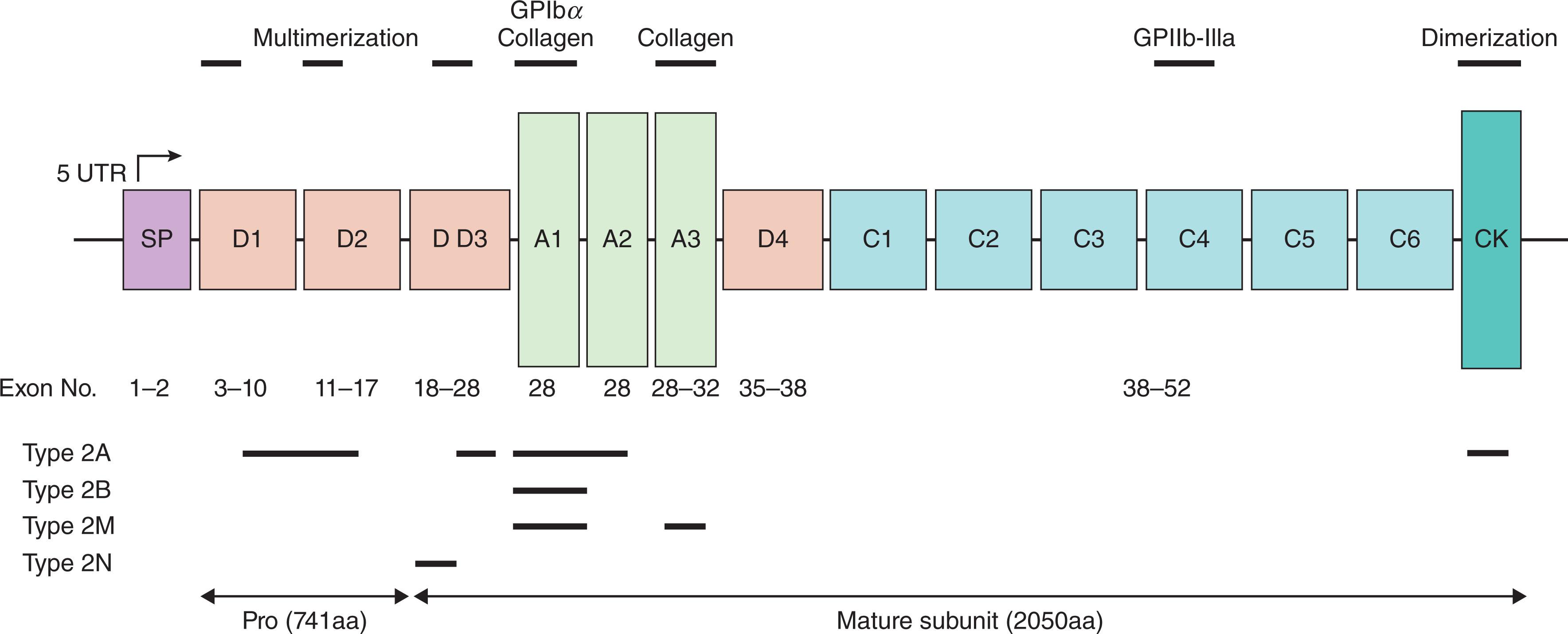
Become a Clinical Tree membership for Full access and enjoy Unlimited articles
If you are a member. Log in here